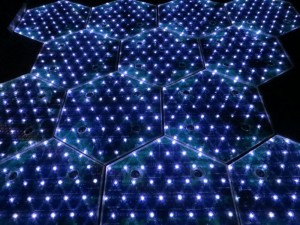May 23 2014
Solar Freakin’ Roadways
 A YouTube video and Indiegogo campaign promise a new solution to our energy woes – “solar freakin’ roadways.”
A YouTube video and Indiegogo campaign promise a new solution to our energy woes – “solar freakin’ roadways.”
The concept is to build roads out of hexagonal plates of transparent hard material (tempered glass) with built in solar panels. You can also incorporate heating elements and LED lights. Buried alongside such roads could be a new energy grid, for transporting all that solar generated electricity.
Here is the vision as presented: With such solar freakin’ roadways we could generate much, if not all, of our needed electricity. We could replace telephone poles and hanging wires with buried lines, and upgrade our energy (and even information) grid while we’re at it.
The heating elements could melt ice and snow, removing the need for plowing or salting roads. Potholes or other damage could be easily repaired by simply replacing the hexagonal units, one at a time, as needed.
The LED lights could be programmable, so that all road lines and traffic notices could simply by programmed in, and changed as needed. Parking lots could adjust spaces as needed – making bigger spaces or adding or removing handicapped spaces based on demand. Recreational areas can also be programmed to be different kinds of courts as desired.
Pressure sensitive plates can also be added, allowing for the road to light up, for example, when an animal is walking across the road, providing real-time warning for drivers.
This all certainly sounds great – just like the roadway of the future you always imagined, maybe even better.
OK – now here comes the skepticism. First let me say that I like the concept, and I’m glad some some research funding is being dedicated to this idea. I also have no problem with privately crowdfunding the idea. If people want to invest in this, go right ahead. I wish them well.
But this is also a good time to consider all the possible roadblocks (pun intended) and potential problems with such a technology. I am just going to list my questions:
Will the heating elements be able to keep up with a snow storm? If not, will the road still need to be plowed, and if it does, will the plow destroy the solar panels? I would imagine that scratching up the surface would reduce the efficiency of the solar panels considerably.
How well with the solar panels hold up to the harshest abuse that we give our roads? How will they hold up to 18-wheelers, Mack trucks, and other heavy loads? What about when people have to come to a screeching halt – will the skid marks eventually build up to be significant? What will be the affect of car crashes? How about dripping oil and other car fluids?
How easy or difficult will it be for people to steal individual panels for their own uses?
What about ice heaving? On paved roads, these lead to potholes. How will heaving affect these roadways? Will it break the connection, rendering entire sections powerless?
All of this leads to the main question – how much will these solar panel roadways cost? What will be the cost of maintenance? What will be the life -expectancy of the average panel? What will be the return on investment, and how will the long term costs compare to our current infrastructure?
I am sure there are other technological considerations (I invite you to add any in the comments). It is also difficult to anticipate all problems and contingencies. What we really need is a test.
It looks like the developers are ready for the next phase – create a stretch of road using these panels (1 mile, 10 miles?) and see how they hold up over a few years. That is really going to be the only way to tell how they will perform in the real world.
It’s also possible that such panels might find a niche use, but not be cost effective for our entire highway infrastructure. For example, they may find a market for private driveways. I would like not to have to plow or shovel my driveway, and it may reduce my energy bills a bit. Also, a driveway takes a lot less abuse than a highway.
Or perhaps parking lots, bike paths, or playgrounds may find a use. Perhaps they will be better for small back roads than highways, or the other way around, or they will be perfect for cities or sidewalks. Maybe airport runways might justify the cost.
Conclusion
As I said – I like the idea of solar freakin’ roadways. The technology has potential. There are also definitely many unanswered questions and we seriously need some real-life testing to answer them.
It seems likely that some version of this technology will be used in some fashion in the future, even if only for some niche indication, rather than replacing every surface that is now paved or concrete.
It also seems likely it will be years before we start seeing these out in the world (probably Japan will have them before everyone else). If the technology does pan out, I can see it taking 20-50 years before significant implementation. It will likely take at least a decade to do sufficient testing to sort out the above questions.
This technology is still in the “hydrogen economy” stage – a great idea, but with practical hurdles that need to be sorted out, and who knows if it is truly coming.






